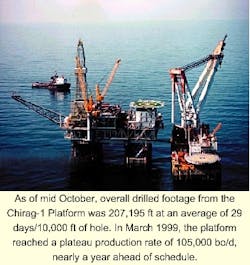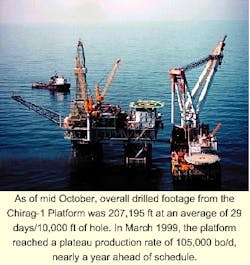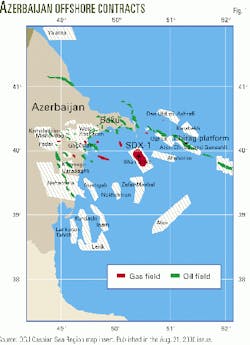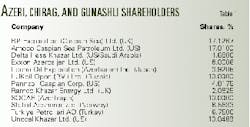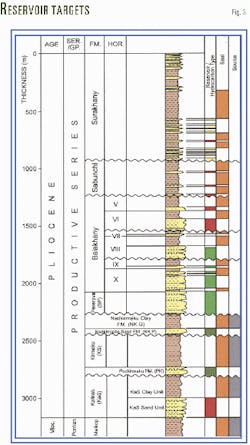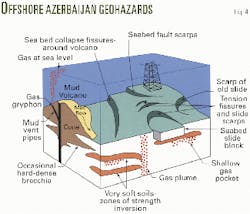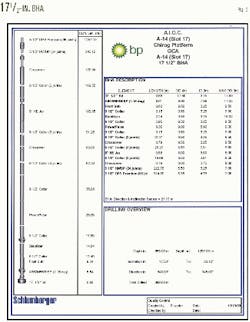Cross-cultural teamwork aided by the effective use of innovative technologies has allowed the Azerbaijan International Operating Co. (AIOC) to overcome drilling and production challenges in the Chirag field.
On Sept. 20, 1994, the State Oil Company of Azerbaijan Republic (SOCAR) signed a Production Sharing Agreement (PSA) for the development of three major Caspian Sea oil fields - Azeri, Chirag, and the deepwater portion of Gunashli (GCA) (Fig. 1). Altogether, these fields contain several billion barrels of proven oil reserves.
When the PSA was signed, it involved a consortium of 11 foreign oil companies from seven countries from the UK, US, Russia, Norway, Japan, Turkey, and Saudi Arabia in addition to SOCAR (Table 1; Also see Caspian Sea pullout map, OGJ, Aug. 21, 2000).
The whole contract area is 450 sq km and the geologic megastructure is 50-55 km long by 3-5 km wide. The Chirag field, discussed below, is positioned in the middle of the megastructure and was discovered in 1984 by SOCAR.
The PSA, with terms covering 30 years of development and production, became effective on Dec. 12, 1994, after ratification by the Azerbaijan parliament. The consortium was called Azerbaijan International Operating Company (AIOC) and was originally staffed with secondees from most of the partner companies. This multicompany team accomplished much of the work described below. From June 1999, BP was named operator of this PSA on behalf of the shareholder companies.
The drilling operation from the Chirag-1 platform became the first Western development in the Azerbaijan Sector of the Caspian Sea and formed an integral part of the program called the "Early Oil Project." The work program for this project included major platform topsides refurbishment and installation, drilling rig modularization, offshore pipeline installation, oil terminal installation, and onshore pipeline upgrades.
To achieve these tasks and to bring first oil to surface, a total of 18 months was required. Despite operational and logistical setbacks, early oil production for AIOC began Nov. 7, 1997, on the 48th anniversary of the second oil boom in Baku. In September 1999, drilling activity temporarily stopped on the Chirag-1 platform upon completion of 14 wells. Activity was resumed in August 2000. As of October 2000, AIOC has drilled 15 wells with 11 producers, 3 water injectors, and 1 awaiting completion.
Achievements
As of mid-October, overall drilled footage from Chirag-1 platform was 207,195 ft at an average of 29 days/10,000 ft.
Forecasted well productivity was and continues to be greatly enhanced through the drilling of high-angle, long departure wells and appropriate sand-control techniques. Wells that were originally predicted to produce 5,000-7,000 bo/d came on stream at double these rates, some reaching 30,000 bo/d.
Upon completion of the first drilling phase in third quarter 1999, the drilling and completion team had set several Caspian Sea records related to penetration rates (890 m/day), departure (3,974 m), and a world-record, 394-m openhole gravel-pack with shunt tube screens.
A plateau production rate of 105,000 bo/d was reached in March 1999, nearly a year ahead of schedule using 10 fewer well slots than planned. These results evolved through an accelerated drilling learning curve, the use of high-angle wells, and a flexible, innovative approach to completion design and installation.
Rig refurbishment
SOCAR began the original construction on the Chirag-1 platform, but the jacket was not completely finished until AIOC assumed operatorship in the field. The existing equipment on the platform did not meet the operator's safety and operational standards. Furthermore, platform inactivity led to lengthy exposure to open air and a lack of maintenance.
An evaluation of the general structural integrity of the jacket confirmed, however, the structure could capably support additional topside equipment with the consideration of seismic loads.
The first activity involved removing the topside facilities and equipment from the platform. The topside deck modules were taken ashore and refitted with a completely refurbished rig and new production equipment. On May 9, 1997, only 20 piles supported the Chirag platform, protruding a few meters above the water. The more visible project construction activities began in the spring of 1997.
For the drilling operations, AIOC selected Deutag Drilling Co. (formerly Kenting Deutag Drilling Co.) as the contractor. From here, Deutag installed land rig No. T-105.
To convert the rig to an offshore-based drilling unit, however, required extensive refitting and refurbishment. This work was performed together with Deutag's engineering sister company, Bentec, in their shipyard in Bad Bentheim, Germany.
Once completed and acceptance tested by AIOC, the 120 truckload rig was dismantled, containerized and sea freighted to a Black Sea port in Turkey. From there, the rig was trucked overland through Turkey and Georgia where it eventually reached its destination at the deepwater stationary platforms plant in Baku. Next, the drilling unit was commissioned, acceptance tested, shipped offshore, and assembled (Fig. 2). Once final acceptance testing took place, drilling activities began on the first well, A-1.
Challenges
Drilling crews spudded well A-1 from the Chirag-1 platform on Aug. 12, 1997. The well was scheduled for 50 days, including an open-hole, gravel-packed completion. The main oil reservoir for all Chirag wells is the Pereriv formation with the Balakhany X as a secondary objective (Fig. 3).
Drilling progressed with some problems related to the 135/8-in. wellhead, severe losses while performing the 133/8-in. cement job, and an ensuing saltwater flow between the 20 and 133/8-in. casing strings. To determine the source of the saltwater flow, the operator ran gamma ray-temperature and segmented-bond acoustic tools. Personnel performed several shut-in periods on the wellhead with pressure build-ups of up to 190 psi. The flow ceased 12 days later.
Having resolved these problems, the 121/4-in. hole section was drilled to the casing point at the base of the Balakhany formation in 8 days. Unfortunately, while tripping out of the hole from section TD, the pipe became stuck and the hole had to be sidetracked just below the 133/8-in. casing.
Drilling the 121/4-in. section for the second time proved to be extremely troublesome with well-control equipment problems, cement contaminated barite, losses from the surface system, lost circulation, slow penetration rates, and extremely erratic torque problems.
Unfortunately, several reconfigurations of the bottomhole assemblies and bit types did not improve conditions and the 95/8-in. casing was eventually set shallower than planned in the Balakhany IX. This necessitated a change from a planned openhole gravel pack completion and cased-hole completion with 7-in. liner.
Despite encountering severe top-drive problems prior to spudding the second well, it was successfully drilled and completed in 40 days using the experience gained from the first well.
Geohazards
Geohazardous conditions in the shallower sections impart high degrees of risk for drilling operations in the Chirag field (Attachment 5). These geohazards include seabed faults, scarps and slopes, mud volcanoes, gas plumes and pockets, and gas gryphons (open channels to surface that are filled with gas and mud).
According to shallow seismic indications, shallow gas is very common over the entire GCA contract area. Nevertheless, drilling operations encountered no signs of shallow gas on the first three wells. Pulse and decay spectra logs (PDK-100 channels) also did not indicate any presence of gas.
Saltwater flows
Shallow high-pressure saltwater flows encountered at the platform location caused brine flow, annular pressure, and severe cement loss problems while running the 133/8-in. cement jobs on the first six wells. The flows came from local sandy layers that occur between 650 and 900 m.
These zones contain brine that became overpressured due to rapid deposition and incomplete dewatering of the clay sequences. In the A-1 and A-3 wells, drilling crews encountered brine flows behind the 133/8-in. casing string that initially produced 600 b/d of brine. Brine flow was first successfully shut-off on the A-4 but resumed in well A-5 during the cement job.
The flow ceased after cement displacement was completed. Personnel assumed that the problem zone encountered in well A-3 at about 350 m provided a conduit between the A-3, A-5, and A-6 wells. Additionally, during the cement job in well A-5, crews observed returns up the 28-in. and 20-in. annuli of well A-3.
It became a challenge to isolate the over-pressured saltwater zone during the 133/8-in. cement job. After several different attempts, the team redesigned the complete cementing system using a high rheology 13.5 ppg lead slurry (15% Litefill) with a 15.8 ppg tail slurry that topped out at 650 m.
Afterwards, the annulus was squeezed to 100 psi and then shut in. This stopped the annular flow and allowed for sufficient strength at the shoe.
Gumbo
Another frustrating problem in the 171/2-in. hole section included a severe gumbo problem, associated with highly reactive, plastic clay formations, which caused the flowline and bell nipple to plug and the shale shakers to overload.
Drilling personnel, however, mitigated the gumbo problem by raising the KCl concentration in the water-based mud to 35-40 lb/bbl and adding 3-5% glycol.
On wells A-12 and A-13, the drillers attempted to improve penetration rates through the anhydrite stringers in the 171/2-in. hole section with a PDC bit. However, this in itself created additional gumbo problems as the cutters tended to ball up.
Other challenges
In subsequent wells, the crews experienced different kinds of drilling problems. These included problems with the top drive, a wellhead seal, measurement-while-drilling tools, cement recipes, increases in KCl concentration in the 171/2-in. section, BHA directional response, steering difficulties at depth, and bit performance.
With increasing inclination and horizontal departure well after well, torque and hydraulics became an issue due to the drilling rig's limited capability. As previously mentioned, the rig T-105 was a land rig, with a 3,000-m drilling design radius. Thus, the rig was constrained by weight, space, torque, and hydraulics.
The drilling crews struggled to deliver excellent performance with a 32,000 ft-lb top drive, limited active and reserve-pit volume, and 5,000-psi pumps that were hydraulically limited beyond 2,500 m measured depth. Solid control equipment and the pipe-handling system also had limited capabilities.
To improve drilling performance and solve problems associated with increasing depth, hole angle, and departure, the team utilized the latest innovations such as synthetic-based mud, downhole adjustable gauge stabilizers, high-speed motors, steering-wheel bits, lubribeads, pressure-while-drilling, and azimuthal density-neutron tools.
Additionally, the use of 51/2-in. drill pipe with high-torque connections (HT-55) in the 121/4-in. hole section, instead of standard 5-in. drill pipe, improved fluid hydraulics and helped overcome torque problems.
Finally, BHA optimization led to refined well profiles as the building tendencies and reduced torque levels allowed a smoother well bore, faster penetration rates, and improved bit performance (Figs. 5 and 6).
Completion strategy
To assist in determining the optimum type of completion for the future field development, AIOC implemented several types of sand-face completions on the first 14 wells:
- Wireline perforations with two guns at 6 shots/ft.
- Openhole gravel pack (OHGP) with wire-wrap screens.
- OHGP with prepacked screens.
- DST/TCP perforated 12 shots/ft-shoot and pull.
- TCP perforated 12 shots/ft, underbalance.
The followings are the latest screened completion and perforating technologies implemented in the Chirag wells:
- OHGP with shunt tube screens (ALLPACK screens).
- Stand-alone multilayered sand screens (PALL screens).
- TCP perforated 7-in., 27 shots/ft, underbalance.
The experience gained through evaluation of production performance provided valuable feedback for the next phase of the Chirag-1 development and subsequent full-field development.
Start-up challenges
For logistical support purposes, SOCAR had enough vessels, although most had structural damage. While the rig and platform components were being refurbished, workers upgraded eight supply boats, one derrick barge, one pipelay barge, the supply base, and a helicopter.
As AIOC was the first western company to operate in the region, the PSA required a grassroots service company structure. In turn, the consortium encouraged Western service companies to enter this market by providing a possibility of future business opportunities.
Building an integrated drilling and completions team from a set of individuals hailing from eight countries and 12 companies also entailed some real challenges. In the beginning of the team building process, language barriers additionally became an issue.
Despite the lack of focus HSE had traditionally received in the area it became a high priority for the operations. The drilling and completions team adopted the best International processes and practices to deliver good safety and environmental performance.
First of all, a "Permit to Work" system was implemented rigorously on the Chirag Platform to control simultaneous drilling and production activities.
A "Risk Management System" has also been used as a way of identifying detailed hazards associated with the operational activities, assessing the risks and assuring that the best technical and safe solutions have been implemented.
Daily meetings became an important focal point for information and responsibility sharing among all team members.
Safety and benchmarking
Over a 3-year period involving rig, platform, infrastructure construction-upgrade activities, and a 14-well drilling and completion program, four lost-time accidents (LTAs) occurred. The average Days Away From Work Case Frequency (DAFWCF) was 0.51/200,000 man-hours and there were no spills to the environment.
Additionally, a focus on continuous improvement resulted in a drilling-and-completion learning curves for 1998 and 1999 that consistently performed in the first and second quartiles based on an Arthur D. Little benchmark study. Drilling performance, which began as 72 days/10,000 ft, improved to 19 days/10,000 ft.
Comparing data with benchmark results provided by Rushmore AS, 13 of 14 completions have been ranked in the first and second quartiles by completion type and length of the completed section.
Average early oil drilling and completion cost from Chirag -1 platform has been $0.47/boe, which is less than half of that found in internationally recognized benchmark values.
The author
Zarifa S. Aliyeva works as a drilling engineer in Baku for BP Exploration. Prior to the signing of the Azeri-Chirag-Gunashli PSA, she worked for the State Oil Co. of Azerbaijan Republic (SOCAR) and then the Azerbaijan International Operating Co. (AIOC). Aliyeva holds a masters degree in petroleum engineering from the Oil Academy in Baku.
